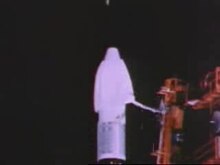Mariner 2
 Depiction of Mariner 2 in space | |
| Mission type | Planetary flyby |
|---|---|
| Operator | NASA / JPL |
| Harvard designation | 1962 Alpha Rho 1[1] |
| COSPAR ID | 1962-041A |
| SATCAT no. | 374 |
| Mission duration | 4 months, 7 days |
| Spacecraft properties | |
| Spacecraft type | Mariner based on Ranger Block I |
| Manufacturer | Jet Propulsion Laboratory |
| Launch mass | 202.8 kilograms (447 lb) |
| Power | 220 watts (at Venus encounter) |
| Start of mission | |
| Launch date | August 27, 1962, 06:53:14 UTC[1] |
| Rocket | Atlas LV-3 Agena-B |
| Launch site | Cape Canaveral LC-12 |
| End of mission | |
| Last contact | January 3, 1963 7:00 UT[2] |
| Orbital parameters | |
| Reference system | Heliocentric |
| Perihelion altitude | 105,464,560 kilometers (56,946,310 nautical miles) |
| Epoch | December 27, 1962 |
| Flyby of Venus | |
| Closest approach | December 14, 1962 |
| Distance | 34,773 kilometers (18,776 nautical miles) |
Mariner | |

Mariner 2 (Mariner-Venus 1962), an American space probe to Venus, was the first robotic space probe to conduct a successful planetary encounter. The first successful spacecraft in the NASA Mariner program, it was a simplified version of the Block I spacecraft of the Ranger program and an exact copy of Mariner 1. The missions of the Mariner 1 and 2 spacecraft are sometimes known as the Mariner R missions. Original plans called for the probes to be launched on the Atlas-Centaur, but serious developmental problems with that vehicle forced a switch to the much smaller Agena B second stage. As such, the design of the Mariner R vehicles was greatly simplified. Far less instrumentation was carried than on the Soviet Venera probes of this period—for example, forgoing a TV camera—as the Atlas-Agena B had only half as much lift capacity as the Soviet 8K78 booster. The Mariner 2 spacecraft was launched from Cape Canaveral on August 27, 1962, and passed as close as 34,773 kilometers (21,607 mi) to Venus on December 14, 1962.[3]
The Mariner probe consisted of a 100 cm (39.4 in) diameter hexagonal bus, to which solar panels, instrument booms, and antennas were attached. The scientific instruments on board the Mariner spacecraft were: two radiometers (one each for the microwave and infrared portions of the spectrum), a micrometeorite sensor, a solar plasma sensor, a charged particle sensor, and a magnetometer. These instruments were designed to measure the temperature distribution on the surface of Venus and to make basic measurements of Venus' atmosphere.
The primary mission was to receive communications from the spacecraft in the vicinity of Venus and to perform radiometric temperature measurements of the planet. A second objective was to measure the interplanetary magnetic field and charged particle environment.[4][5]
En route to Venus, Mariner 2 measured the solar wind, a constant stream of charged particles flowing outwards from the Sun, confirming the measurements by Luna 1 in 1959. It also measured interplanetary dust, which turned out to be scarcer than predicted. In addition, Mariner 2 detected high-energy charged particles coming from the Sun, including several brief solar flares, as well as cosmic rays from outside the Solar System. As it flew by Venus on December 14, 1962, Mariner 2 scanned the planet with its pair of radiometers, revealing that Venus has cool clouds and an extremely hot surface.
Spacecraft and subsystems[]

The Mariner 2 spacecraft was designed and built by the Jet Propulsion Laboratory of the California Institute of Technology.[6] It consisted of a hexagonal base, 1.04 meters (41 in) wide and 0.36 meters (14 in) high, which contained six magnesium chassis housing the electronics for the science experiments, communications, data encoding, computing, timing, and attitude control, and the power control, battery, and battery charger, as well as the attitude control gas bottles and the rocket engine. On top of the base was a tall pyramid-shaped mast on which the science experiments were mounted, which brought the total height of the spacecraft to 3.66 meters (12.0 ft). Attached to either side of the base were rectangular solar panel wings with a total span of 5.05 meters (16.6 ft) and width of 0.76 meters (2.5 ft). Attached by an arm to one side of the base and extending below the spacecraft was a large directional dish antenna.[citation needed] The power system of Mariner 2 consisted of two solar cell wings, one 183 by 76 centimeters (72 by 30 in) and the other 152 by 76 centimeters (60 by 30 in) (with a 31 centimeters (12 in) dacron extension (a solar sail) to balance the solar pressure on the panels), which powered the craft directly or recharged a 1000 watt-hour sealed silver-zinc cell battery. This battery was used before the panels were deployed, when the panels were not illuminated by the Sun, and when loads were heavy. A power-switching and booster regulator device controlled the power flow. Communications consisted of a 3-watt transmitter capable of continuous telemetry operation, the large high gain directional dish antenna, a cylindrical omnidirectional antenna at the top of the instrument mast, and two command antennas, one on the end of either solar panel, which received instructions for midcourse maneuvers and other functions.[citation needed]
Propulsion for midcourse maneuvers was supplied by a monopropellant (anhydrous hydrazine) 225 newtons (51 lbf) retro-rocket. The hydrazine was ignited using nitrogen tetroxide and aluminum oxide pellets, and thrust direction was controlled by four jet vanes situated below the thrust chamber. Attitude control with a 1 degree pointing error was maintained by a system of nitrogen gas jets. The Sun and Earth were used as references for attitude stabilization. Overall timing and control was performed by a digital Central Computer and Sequencer. Thermal control was achieved through the use of passive reflecting and absorbing surfaces, thermal shields, and movable louvers.[citation needed]
Scientific instruments[]
Only 18 kilograms (40 lb) of the spacecraft could be allocated to scientific experiments.[7]
Summary of instruments:[8]
- Microwave radiometer
- Infrared radiometer
- Three axis fluxgate magnetometer
- Cosmic ray detector
- Cosmic dust detector
- Solar plasma spectrometer
- Particle detector
The following scientific instruments were mounted on the instrument mast and base:
- A two-channel microwave radiometer of the crystal video type operating in the standard Dicke mode of chopping between the main antenna, pointed at the target, and a reference horn pointed at cold space.[9] It was used to determine the absolute temperature of Venus' surface and details concerning its atmosphere through its microwave-radiation characteristics, including the daylight and dark hemispheres, and in the region of the terminator. Measurements were performed simultaneously in two frequency bands of 13.5 mm and 19 mm.[7][10] The total weight of the radiometer was 10 kilograms (22 lb). Its average power consumption was 4 watts and its peak power consumption 9 watts.[11]
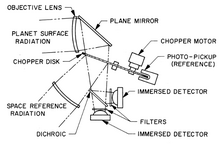
- A two-channel infrared radiometer to measure the effective temperatures of small areas of Venus. The radiation that was received could originate from the planetary surface, clouds in the atmosphere, the atmosphere itself or a combination of these. The radiation was received in two spectral ranges: 8 to 9 μm (focused on 8.4 μm) and 10 to 10.8 μm (focused on 10.4 μm).[7] The latter corresponding to the carbon dioxide band.[12] The total weight of the infrared radiometer, which was housed in a magnesium casting, was 1.3 kilograms (2.9 lb), and it required 2.4 watts of power. It was designed to measure radiation temperatures between approximately 200 and 500 K (−73 and 227 °C; −100 and 440 °F).[13]
- A three-axis fluxgate magnetometer to measure planetary and interplanetary magnetic fields.[7] Three probes were incorporated in its sensors, so it could obtain three mutually orthogonal components of the field vector. Readings of these components were separated by 1.9 seconds. It had three analog outputs that had each two sensitivity scales: ± 64 γ and ± 320 γ (1 γ = 1 nanotesla). These scales were automatically switched by the instrument. The field that the magnetometer observed was the super-position of a nearly constant spacecraft field and the interplanetary field. Thus, it effectively measured only the changes in the interplanetary field.[14]
- An ionization chamber with matched Geiger-Müller tubes (also known as a cosmic ray detector) to measure high-energy cosmic radiation.[7][15]
- A particle detector (implemented through use of an Anton type 213 Geiger-Müller tube) to measure lower radiation (especially near Venus),[7][16] also known as the Iowa detector, as it was provided by the University of Iowa.[15] It was a miniature tube having a 1.2 mg/cm2 mica window about 0.3 centimeters (0.12 in) in diameter and weighing about 60 grams (2.1 oz). It detected soft x-rays efficiently and ultraviolet inefficiently, and was previously used in Injun 1, Explorer 12 and Explorer 14.[16] It was able to detect protons above 500 keV in energy and electrons above 35 keV.[4] The length of the basic telemetry frame was 887.04 seconds. During each frame, the counting rate of the detector was sampled twice at intervals separated by 37 seconds. The first sampling was the number of counts during an interval of 9.60 seconds (known as the 'long gate'); the second was the number of counts during an interval of 0.827 seconds (known as the 'short gate'). The long gate accumulator overflowed on the 256th count and the short gate accumulator overflowed on the 65,536th count. The maximum counting rate of the tube was 50,000 per second.[16]
- A cosmic dust detector to measure the flux of cosmic dust particles in space.[7]
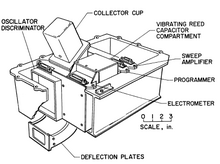
- A solar plasma spectrometer to measure the spectrum of low-energy positively charged particles from the Sun, i.e. the solar wind.[7]
The magnetometer was attached to the top of the mast below the omnidirectional antenna. Particle detectors were mounted halfway up the mast, along with the cosmic ray detector. The cosmic dust detector and solar plasma spectrometer were attached to the top edges of the spacecraft base. The microwave radiometer, the infrared radiometer and the radiometer reference horns were rigidly mounted to a 48 centimeters (19 in) diameter parabolic radiometer antenna mounted near the bottom of the mast. All instruments were operated throughout the cruise and encounter modes except the radiometers, which were only used in the immediate vicinity of Venus.
In addition to these scientific instruments, Mariner 2 had a data conditioning system (DCS) and a scientific power switching (SPS) unit. The DCS was a solid-state electronic system designed to gather information from the scientific instruments on board the spacecraft. It had four basic functions: analog-to-digital conversion, digital-to-digital conversion, sampling and instrument-calibration timing, and planetary acquisition. The SPS unit was designed to perform the following three functions: control of the application of AC power to appropriate portions of the science subsystem, application of power to the radiometers and removal of power from the cruise experiments during radiometer calibration periods, and control of the speed and direction of the radiometer scans. The DCS sent signals to the SPS unit to perform the latter two functions.[7]
Mission objectives[]
The scientific objectives were:[4]
- Radiometer experiment.
- Infrared experiment.
- Magnetometer experiment.
- Charged particles experiment.
- Plasma experiment.
- Micrometeorite experiment.
Besides the experiments with the scientific instruments, the objectives of both the Mariner 1 and 2 probes included also engineering objectives:[4]
- Evaluation of the attitude control system.
- Evaluation of the environmental control system.
- Evaluation of the entire power system.
- Evaluation of the communication system.
Mission profile[]
Launch[]
This section needs additional citations for verification. (December 2017) |
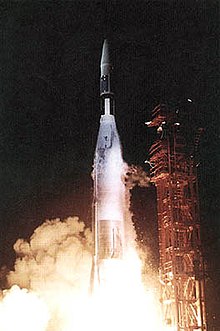
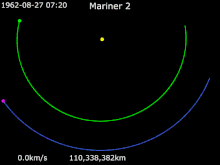
Mariner 2 · Venus · Earth
Mariner 2 was launched from Cape Canaveral Air Force Station Launch Complex 12 at 06:53:14 UTC on August 27, 1962 by a two-stage Atlas-Agena rocket.[7][17]
The two-stage Atlas-Agena rocket carrying Mariner 1 had veered off-course during its launch on July 22, 1962 due to a defective signal from the Atlas and a bug in the program equations of the ground-based guidance computer, and so the spacecraft was destroyed by the Range Safety Officer.
Two days after that launch, the backup probe and booster (Atlas vehicle 179D) were rolled out to LC-12. The Atlas proved troublesome to prepare for launch, and multiple serious problems with the autopilot occurred, including a complete replacement of the servoamplifier after it had suffered component damage due to shorted transistors. At 1:53 AM EST on August 27, Mariner 2 was launched.
The flight proceeded normally up to the point of booster engine cutoff, at which point the V-2 vernier engine lost pitch and yaw control. The vernier started oscillating and banging against its stops, resulting in a rapid roll of the launch vehicle that came close to threatening the integrity of the stack. At T+189 seconds, the rolling stopped and the launch continued without incident. The rolling motion of the Atlas resulted in ground guidance losing its lock on the booster and preventing any backup commands from being sent to counteract the roll. The incident was traced to a loose electrical connection in the vernier feedback transducer, which was pushed back into place by the centrifugal force of the roll, which also by fortunate coincidence left the Atlas only a few degrees off from where it started and within the range of the Agena's horizontal sensor. As a consequence of this episode, GD/A implemented improved fabrication of wiring harnesses and checkout procedures.
Five minutes after liftoff, the Atlas and Agena-Mariner separated, followed by the first Agena burn and second Agena burn. The Agena-Mariner separation injected the Mariner 2 spacecraft into a geocentric escape hyperbola at 26 minutes 3 seconds after liftoff. The NASA NDIF tracking station at Johannesburg, South Africa, acquired the spacecraft about 31 minutes after launch. Solar panel extension was completed approximately 44 minutes after launch. The Sun lock acquired the Sun about 18 minutes later. The high-gain antenna was extended to its acquisition angle of 72°. The output of the solar panels was slightly above the predicted value.
As all subsystems were performing normally, with the battery fully charged and the solar panels providing adequate power, the decision was made on August 29 to turn on cruise science experiments. On September 3, the Earth acquisition sequence was initiated, and Earth lock was established 29 minutes later.[7]
Mid-course maneuver[]
Due to the Atlas-Agena putting Mariner slightly off course, the spacecraft required a mid-course correction, consisting of a roll-turn sequence, followed by a pitch-turn sequence and finally a motor-burn sequence. Preparation commands were sent to the spacecraft at 21:30 UTC on September 4. Initiation of the mid-course maneuver sequence was sent at 22:49:42 UTC and the roll-turn sequence started one hour later. The entire maneuver took approximately 34 minutes.[7]
Due to the mid-course maneuver, the sensors lost their lock with the Sun and Earth. At 00:27:00 UTC the Sun re-acquisition began and at 00:34 UTC the Sun was reacquired. Earth re-acquisition started at 02:07:29 UTC and Earth was reacquired at 02:34 UTC.[7]
Loss of attitude control[]
On September 8 at 12:50 UTC, the spacecraft experienced a problem with attitude control. It automatically turned on the gyros, and the cruise science experiments were automatically turned off. The exact cause is unknown as attitude sensors went back to normal before telemetry measurements could be sampled, but it may have been an Earth-sensor malfunction or a collision with a small unidentified object which temporarily caused the spacecraft to lose Sun lock. A similar experience happened on September 29 at 14:34 UTC. Again, all sensors went back to normal before it could be determined which axis had lost lock. By this date, the Earth sensor brightness indication had essentially gone to zero. This time, however, telemetry data indicated that the Earth-brightness measurement had increased to the nominal value for that point in the trajectory.[7]
Solar panel output[]
On October 31, the output from one solar panel (with solar sail attached) deteriorated abruptly. It was diagnosed as a partial short circuit in the panel. As a precaution, the cruise science instruments were turned off. A week later, the panel resumed normal function, and cruise science instruments were turned back on. The panel permanently failed on November 15, but Mariner 2 was close enough to the Sun that one panel could supply adequate power; thus, the cruise science experiments were left active.[7]
Encounter with Venus[]
Mariner 2 was the first spacecraft to successfully encounter another planet,[18] passing as close as 34,773 kilometers (21,607 mi) to Venus after 110 days of flight on December 14, 1962.[3]
Post encounter[]
After encounter, cruise mode resumed. Spacecraft perihelion occurred on December 27 at a distance of 105,464,560 kilometers (65,532,640 mi). The last transmission from Mariner 2 was received on January 3, 1963 at 07:00 UTC, making the total time from launch to termination of the Mariner 2 mission 129 days.[19] Mariner 2 remains in heliocentric orbit.
Results[]
The data produced during the flight consisted of two categories--viz., tracking data and telemetry data.[19] One particularly noteworthy piece of data gathered during the pioneering fly-by was the high temperature of the atmosphere,[20] measured to be 500 °C (773 K; 932 °F).[20] Various properties of the solar wind were also measured for the first time.[20]
Scientific observations[]
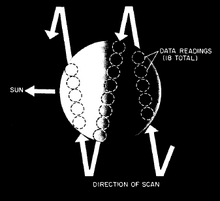
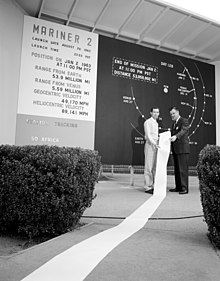
The microwave radiometer made three scans of Venus in 35 minutes on December 14, 1962 starting at 18:59 UTC.[11] The first scan was made on the dark side, the second was near the terminator, and the third was located on the light side.[11][21] The scans with the 19 mm band revealed peak temperatures of 490 ± 11 K (216.9 ± 11.0 °C; 422.3 ± 19.8 °F) on the dark side, 595 ± 12 K near the terminator, and 511 ± 14 K on the light side.[22] It was concluded that there is no significant difference in temperature across Venus.[11][21] However, the results suggest a limb darkening, an effect which presents cooler temperatures near the edge of the planetary disk and higher temperatures near the center.[9][10][11][21][22][23] This was evidence for the theory that the Venusian surface was extremely hot and the atmosphere optically thick.[11][21][22]
The infrared radiometer showed that the 8.4 μm and 10.4 μm radiation temperatures were in agreement with radiation temperatures obtained from Earth-based measurements.[13] There was no systematic difference between the temperatures measured on the light side and dark side of the planet, which was also in agreement with Earth-based measurements.[13] The limb darkening effect that the microwave radiometer detected was also present in the measurements by both channels of the infrared radiometer.[13][21][23] The effect was only slightly present in the 10.4 μm channel but was more pronounced in the 8.4 μm channel.[21] The 8.4 μm channel also showed a slight phase effect. The phase effect indicated that if a greenhouse effect existed, heat was transported in an efficient manner from the light side to the dark side of the planet.[21] The 8.4 μm and 10.4 μm showed equal radiation temperatures, indicating that the limb darkening effect would appear to come from a cloud structure rather than the atmosphere.[13] Thus, if the measured temperatures were actually cloud temperatures instead of surface temperatures, then these clouds would have to be quite thick.[12][21][23]
The magnetometer detected a persistent interplanetary magnetic field varying between 2 γ and 10 γ (nanotesla), which agrees with prior Pioneer 5 observations from 1960. This also means that interplanetary space is rarely empty or field-free.[14] The magnetometer could detect changes of about 4 γ on any of the axes, but no trends above 10 γ were detected near Venus, nor were fluctuations seen like those that appear at Earth's magnetospheric termination. This means that Mariner 2 found no detectable magnetic field near Venus, although that didn't necessarily mean that Venus had none.[21][24] However, if Venus had a magnetic field, then it would have to be at least smaller than 1/10 the magnetic field of the Earth.[24][25] In 1980, the Pioneer Venus Orbiter indeed showed that Venus has a small weak magnetic field.[26]
The Anton type 213 Geiger-Müller tube performed as expected.[27] The average rate was 0.6 counts per second. Increases in its counting rate were larger and more frequent than for the two larger tubes, since it was more sensitive to particles of lower energy.[7] It detected 7 small solar bursts of radiation during September and October and 2 during November and December.[28] The absence of a detectable magnetosphere was also confirmed by the tube; it detected no radiation belt at Venus similar to that of Earth. The count rate would have increased by 104, but no change was measured.[7][29]
It was also shown that in interplanetary space, the solar wind streams continuously,[17][30] confirming a prediction by Eugene Parker,[31] and the cosmic dust density is much lower than the near-Earth region.[32] Improved estimates of Venus' mass and the value of the Astronomical Unit were made. Also, research, which was later confirmed by Earth-based radar and other explorations, suggested that Venus rotates very slowly and in a direction opposite that of the Earth.[33]
See also[]
- List of missions to Venus
- Microwave Radiometer (Juno), another microwave radiometer used in the 2010s on Jupiter
References[]
- ^ Jump up to: a b McDowell, Jonathan. "Launch Log". Jonathan's Space Page. Retrieved September 12, 2013.
- ^ Shea, Garrett (September 20, 2018). "Beyond Earth: A Chronicle of Deep Space Exploration". NASA.
- ^ Jump up to: a b "Mariner 2". US National Space Science Data Center. Retrieved September 8, 2013.
- ^ Jump up to: a b c d
Jet Propulsion Laboratory (under contract for NASA) (June 15, 1962). "Tracking Information Memorandum No. 332-15: Mariner R 1 and 2" (PDF). California Institute of Technology. Retrieved January 24, 2008. Cite journal requires
|journal=(help) - ^
Renzetti, N.A. (July 1, 1965). "Technical Memorandum No. 33-212: Tracking and Data Acquisition Support for the Mariner Venus 1962 Mission" (PDF). NASA. Retrieved January 24, 2008. Cite journal requires
|journal=(help) - ^ "The Mission of Mariner II: Preliminary Observations - Profile of Events". Science. New Series. 138 (3545): 1095. December 7, 1962. Bibcode:1962Sci...138.1095.. doi:10.1126/science.138.3545.1095. PMID 17772964. S2CID 11892630.
- ^ Jump up to: a b c d e f g h i j k l m n o p q
Jet Propulsion Laboratory (under contract for NASA) (July 1965). "Mariner-Venus 1962, Final Project Report" (PDF). California Institute of Technology. Retrieved January 27, 2008. Cite journal requires
|journal=(help) - ^ "Mariner 2 - Venus Missions - NASA Jet Propulsion Laboratory". NASA Jet Propulsion Laboratory (JPL).
- ^ Jump up to: a b
Jones, Douglas E. (January 1, 1966). "Technical Report No. 32-722: The Mariner II Microwave Radiometer Experiment" (PDF). Jet Propulsion Laboratory, California Institute of Technology. Retrieved February 15, 2009. Cite journal requires
|journal=(help) - ^ Jump up to: a b Barath, F.T.; Barrett, A.H.; Copeland, J.; Jones, D.E.; Lilley, A.E. (February 1964). "Symposium on Radar and Radiometric Observations of Venus during the 1962 Conjunction: Mariner 2 Microwave Radiometer Experiment and Results". The Astronomical Journal. 69 (1): 49–58. Bibcode:1964AJ.....69...49B. doi:10.1086/109227.
- ^ Jump up to: a b c d e f Barath, F.T.; Barrett, A.H.; Copeland, J.; Jones, D.E.; Lilley, A.E. (March 8, 1963). "Mariner II: Preliminary Reports on Measurements of Venus - Microwave Radiometers". Science. New Series. 139 (3558): 908–909. Bibcode:1963Sci...139..908B. doi:10.1126/science.139.3558.908. PMID 17743052.
- ^ Jump up to: a b Chase, S.C.; Kaplan, L.D.; Neugebauer, G. (March 8, 1963). "Mariner II: Preliminary Reports on Measurements of Venus - Infrared Radiometer". Science. New Series. 139 (3558): 907–908. Bibcode:1963Sci...139..907C. doi:10.1126/science.139.3558.907. PMID 17743051.
- ^ Jump up to: a b c d e Chase, S.C.; Kaplan, L.D.; Neugebauer, G. (November 15, 1963). "The Mariner 2 Infrared Radiometer Experiment" (PDF). Journal of Geophysical Research. 68 (22): 6157–6169. Bibcode:1963JGR....68.6157C. doi:10.1029/jz068i022p06157. Retrieved February 14, 2009.
- ^ Jump up to: a b Coleman, Jr., Paul J.; Davis, Jr., Leverett; Smith, Edward J.; Sonett, Charles P. (December 7, 1962). "The Mission of Mariner II: Preliminary Observations - Interplanetary Magnetic Fields". Science. New Series. 138 (3545): 1099–1100. Bibcode:1962Sci...138.1099C. doi:10.1126/science.138.3545.1099. PMID 17772967. S2CID 19708490.CS1 maint: multiple names: authors list (link)
- ^ Jump up to: a b Anderson, Hugh R. (January 4, 1963). "Mariner II: High-Energy-Radiation Experiment". Science. New Series. 139 (3549): 42–45. Bibcode:1963Sci...139...42A. doi:10.1126/science.139.3549.42. PMID 17752023.
- ^ Jump up to: a b c Van Allen, James A.; Frank, Louis A. (December 7, 1962). "The Mission of Mariner II: Preliminary Observations - The Iowa Radiation Experiment". Science. New Series. 138 (3545): 1097–1098. Bibcode:1962Sci...138.1097V. doi:10.1126/science.138.3545.1097. PMID 17772965.
- ^ Jump up to: a b Neugebauer, M.; Snyder, C.W. (December 7, 1962). "The Mission of Mariner II: Preliminary Observations - Solar Plasma Experiment". Science. New Series. 138 (3545): 1095–1097. Bibcode:1962Sci...138.1095N. doi:10.1126/science.138.3545.1095-a. PMID 17772963. S2CID 24287222.
- ^ Siddiqi, Asif A. (2018). Beyond Earth: A Chronicle of Deep Space Exploration, 1958–2016 (PDF). The NASA history series (second ed.). Washington, DC: NASA History Program Office. p. 1. ISBN 9781626830424. LCCN 2017059404. SP2018-4041.
- ^ Jump up to: a b
Sparks, D.B. (March 1963). "The Mariner 2 Data Processing System". California Institute of Technology. Archived from the original (fee required) on June 16, 2011. Retrieved January 28, 2008. Cite journal requires
|journal=(help) - ^ Jump up to: a b c Administrator, NASA Content (March 6, 2015). "Mariner 2". NASA.
- ^ Jump up to: a b c d e f g h i Sonett, Charles P. (December 1963). "A Summary Review of the Scientific Findings of the Mariner Venus Mission". Space Science Reviews. 2 (6): 751–777. Bibcode:1963SSRv....2..751S. doi:10.1007/BF00208814. S2CID 119555288.
- ^ Jump up to: a b c Pollack, James B.; Sagan, Carl (October 1967). "An Analysis of the Mariner 2 Microwave Observations of Venus". The Astrophysical Journal. 150: 327–344. Bibcode:1967ApJ...150..327P. doi:10.1086/149334.
- ^ Jump up to: a b c
Kaplan, L.D. (June 1964). "Venus, Recent Physical Data for" (PDF). Retrieved February 15, 2009. Cite journal requires
|journal=(help) - ^ Jump up to: a b Smith, Edward .J.; Davis, Jr., Leverett; Coleman, Jr., Paul J.; Sonett, Charles P. (March 8, 1963). "Mariner II: Preliminary Reports on Measurements of Venus - Magnetic Field". Science. New Series. 139 (3558): 909–910. Bibcode:1963Sci...139..909S. doi:10.1126/science.139.3558.909. PMID 17743053. S2CID 220082267.CS1 maint: multiple names: authors list (link)
- ^ Smith, Edward J.; Davis, Jr., Leverett; Coleman, Jr., Paul J.; Sonett, Charles P. (1965). "Magnetic Measurements near Venus" (PDF). Journal of Geophysical Research. 70 (7): 1571. Bibcode:1965JGR....70.1571S. doi:10.1029/JZ070i007p01571. Retrieved February 15, 2009.CS1 maint: multiple names: authors list (link)
- ^ Kivelson, Margaret G.; Russell, Christopher T. (1995). Introduction to Space Physics. Cambridge University Press. ISBN 978-0-521-45714-9.
- ^ Van Allen, James A. (July 1964). "Survival of Thin Films in Space" (PDF). Journal of Geophysical Research. Department of Physics and Astronomy, State University of Iowa. 69 (19): 4170. Bibcode:1964JGR....69.4170V. doi:10.1029/JZ069i019p04170. Retrieved February 15, 2009.
- ^
James, J.N. "Mariner II" (PDF). Retrieved February 15, 2009. Cite journal requires
|journal=(help) - ^ Frank, L.A.; Van Allen, J.A.; Hills, H.K. (March 8, 1963). "Mariner II: Preliminary Reports on Measurements of Venus - Charged Particles". Science. New Series. 139 (3558): 905–907. Bibcode:1963Sci...139..905F. doi:10.1126/science.139.3558.905. PMID 17743050. S2CID 44822394.
- ^ Ness, N.F.; Wilcox, J.M. (October 12, 1964). "Solar Origin of the Interplanetary Magnetic Field". Physical Review Letters. 13 (15): 461–464. Bibcode:1964PhRvL..13..461N. doi:10.1103/PhysRevLett.13.461. hdl:2060/19650019810.
- ^ Chang, Kenneth (August 10, 2018). "NASA's Parker Solar Probe Is Named for Him. 60 Years Ago, No One Believed His Ideas About the Sun". New York Times.
After Mariner 2, “everyone agreed the solar wind existed,” Dr. Parker said.
- ^ Alexander, W.M. (December 7, 1962). "The Mission of Mariner II: Preliminary Results - Cosmic Dust". Science. New Series. 138 (3545): 1098–1099. Bibcode:1962Sci...138.1098A. doi:10.1126/science.138.3545.1098. PMID 17772966.
- ^ Goldstein, R.M.; Carpenter, R.L. (March 8, 1963). "Rotation of Venus: Period Estimated from Radar Measurements". Science. New Series. 139 (3558): 910–911. Bibcode:1963Sci...139..910G. doi:10.1126/science.139.3558.910. PMID 17743054. S2CID 21133097.
External links[]
- Mariner 2 Mission Profile by NASA's Solar System Exploration
- Full-scale engineering prototype of Mariner 2 in the Smithsonian Air and Space Museum, Washington, D.C.
- Mariner 2
| Wikimedia Commons has media related to Mariner 2. |
- Derelict satellites in heliocentric orbit
- Mariner program
- Missions to Venus
- Spacecraft launched in 1962
- Derelict space probes
- Spacecraft launched by Atlas-Agena rockets
